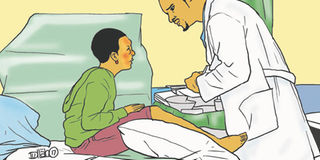Case of a young girl with kidney disorder

Illustration of a doctor examining the young girl.PHOTO|YOUR HEALTH
What you need to know:
- The young girl narrated that the swelling was a gradual process, where it initially began as puffiness around the eyes with decreased urine output. Upon examination at the hospital, she looked weak and her lower limbs were swollen [edema]. Actually doctors use the term ‘edema’ when they are referring to swelling due to accumulation of excessive fluid in tissues.
Last week a beautiful and a confident 14-year-old girl walked into the hospital I work at with complaints of swollen face and swollen limbs. She was a form two secondary school student from Kondoa.
The young girl narrated that the swelling was a gradual process, where it initially began as puffiness around the eyes with decreased urine output. Upon examination at the hospital, she looked weak and her lower limbs were swollen [edema]. Actually doctors use the term ‘edema’ when they are referring to swelling due to accumulation of excessive fluid in tissues.
On systemic examination nothing significant was revealed.
Then a battery of tests was ordered, including but not limited to a full blood count. The patient was then admitted in the female medical ward, awaiting diagnosis.
The provisional diagnosis was a kidney disease known as ‘nephrotic syndrome.’ Have you ever heard of the disease before?
Her eagerness to know what she had
I always like to interact with my patients without prejudice to my professional ethics, hearing their stories and walking in their shoes, which helps me to serve them with integrity.
I remember asking my young patient if she knew what she was suffering from. She responded, “Ndio, nimeambiwa naumwa figo”. (Yes I do, I have been informed that I am suffering from kidney disease.)
She was right but I had to explain to her the kind of kidney disease that she was diagnosed with.
ou know in bongo, you must be able to translate what you know in English or any other language into Swahili. Thus the challenge was how could I translate the condition of “Nephrotic Syndrome” in Swahili or a vernacular language familiar to her?
Then I had to find a simple and brief explanation, I confidently interpreted, “The nature of this kidney disease leads to proteins spillage and kidney damage”.
She was taken aback but I kept her calm by assuring her that we could treat the disease. I was avoiding to say that we are going to cure the disease since I knew that the disease is incurable, but you better tell someone the truth without causing psychological trauma as I eventually did.
According to Mayo Clinic, nephrotic syndrome is a kidney disorder that causes your body to excrete too much proteins in your urine.
Normally doctors classify the syndrome as either primary or secondary depending on the nature and cause but due to diagnostic challenges in most parts of Tanzania, doctors end up treating the disease without knowing the cause. Mind you, they treat it not cure it.
If it’s incurable then why should we look for the cause?
To determine the nature or the cause, you may be required to do some rather complex, expensive and at times not readily available tests such as renal biopsy among others.
So simply put, nephrotioc syndrome is a group of signs and symptoms that altogether indicate that your kidneys are not working properly as they should.
Some signs and symptoms include swelling of your leg, feet, ankles, face and sometimes the whole body, a condition medically known as “anasarca.”
On top of that there will be too much proteins in your urine, too little proteins in your body, too much cholesterol in your body and high level of triglycerides in your body.
When her lab results came out, it showed that she had proteins in urine, what we initially also claimed.
On top of that, we also did an ultrasound of the abdomen whereby it showed that the kidney was damaged.
Thus we concluded that the patient had “nephrotic syndrome with renal failure.”
What you should know
• Risk group; people of all ages can get this disease, though it is said to be more common in men than women, though in this case it was a young girl.
• Causes of nephrotic syndrome include all diseases that damage the kidneys (primary type), and other secondary causes which are systemic disease like diabetes, Systemic Lupus Erythmatus (S.L.E). so you have to seek treatment at the earliest for any disease that damages your kidneys or that might cause nephrotic syndrome.
How was the girl treated ?
Whilst in the ward, the girl was given relevant medication and she was counseled to strictly limit fluid intake and to take low salt diet.
This young girl was just concerned about being at a boarding school with such arrangements for special diet, a diet with good fats/ unsaturated fats and low salt.
My honest advice to all other victims
A word of encouragement is that for those who are still struggling with nephrotic syndrome, there is a silver lining at the end of the tunnel. With a doctor’s support, things do get better; do not ever think that your life is shattered just because of this syndrome.
The author is a medical doctor based in Dodoma.




